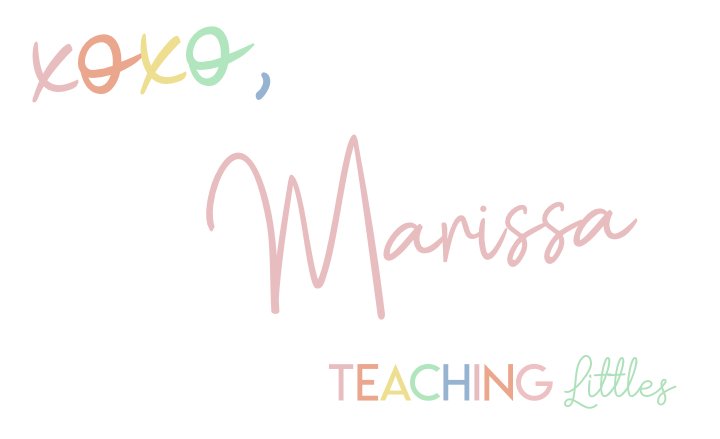Did you know that sensory play is vital for your baby’s development? Sensory play is designed to help babies learn about their surroundings and how to operate their bodies.
Sensory play can start at a very young age, so even a little newborn can participate in activities during their wake windows. Starting sensory play early helps to encourage the development of all senses and gives them a better understanding of their surroundings.

What is sensory play for babies?
Sensory play is a broad term for any activity that stimulates the senses- touch, sight, smell, etc.
So you can make almost any activity into a sensory activity for your baby, which makes planning super simple!
When should you start sensory play with babies?
You can start sensory play with babies as newborns! I know you may be thinking “how can a newborn play?”, but there are lots of ways to start engaging senses even in tiny babies!
Related Post: Black and White Cards for Visual Stimulation in Newborn Babies- Free Printable
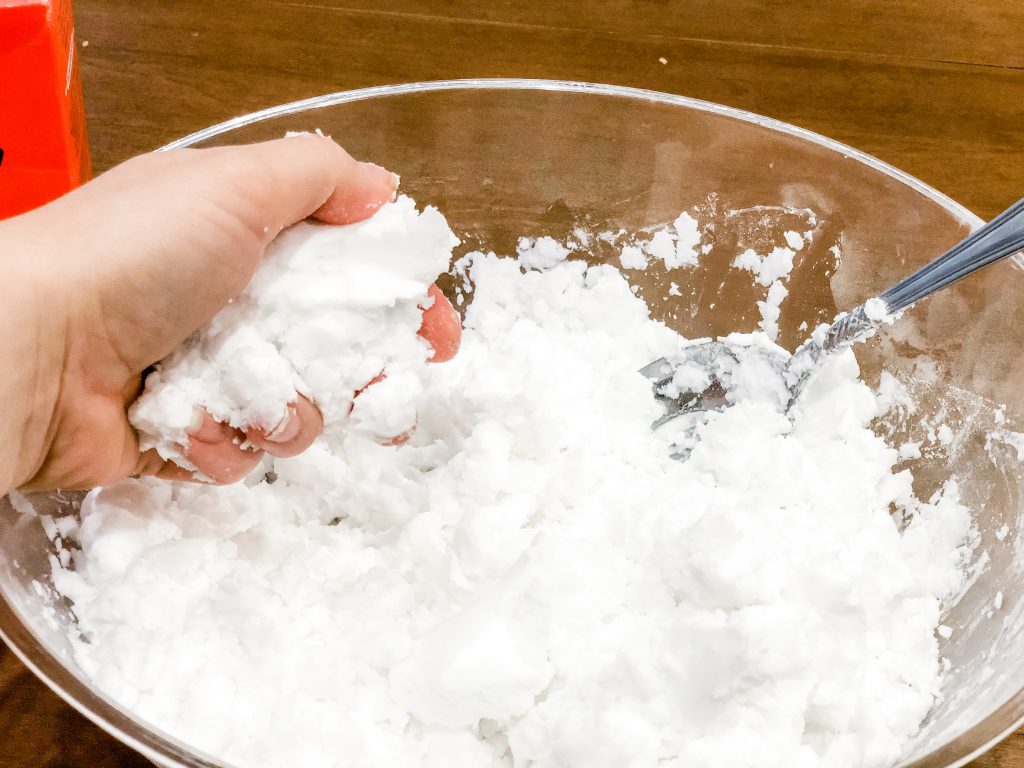
How do you do sensory play with a baby?
When doing sensory play, you want to engage baby’s senses. It is important that your activity stimulates multiple senses (sight, smell, taste, touch and sound).
Things like sensory bins, sensory bottles, high contrast cards, walks and tasting new foods can all be considered sensory play! Sensory play doesn’t have to be complicated or overwhelming!
Related Post: How to Make Simple DIY Glitter Sensory Bottles
Why is it so important to encourage sensory play?
When you encourage sensory play, you are encouraging development. Sensory play not only teaches little ones about experiencing new things, but drives curiosity and sharpens problem solving skills.
We all know that children are little sponges and engaging in sensory play helps littles to learn about the world around them and make vital connections in their brain.
Sensory play is a wonderful tool for language development and communication.
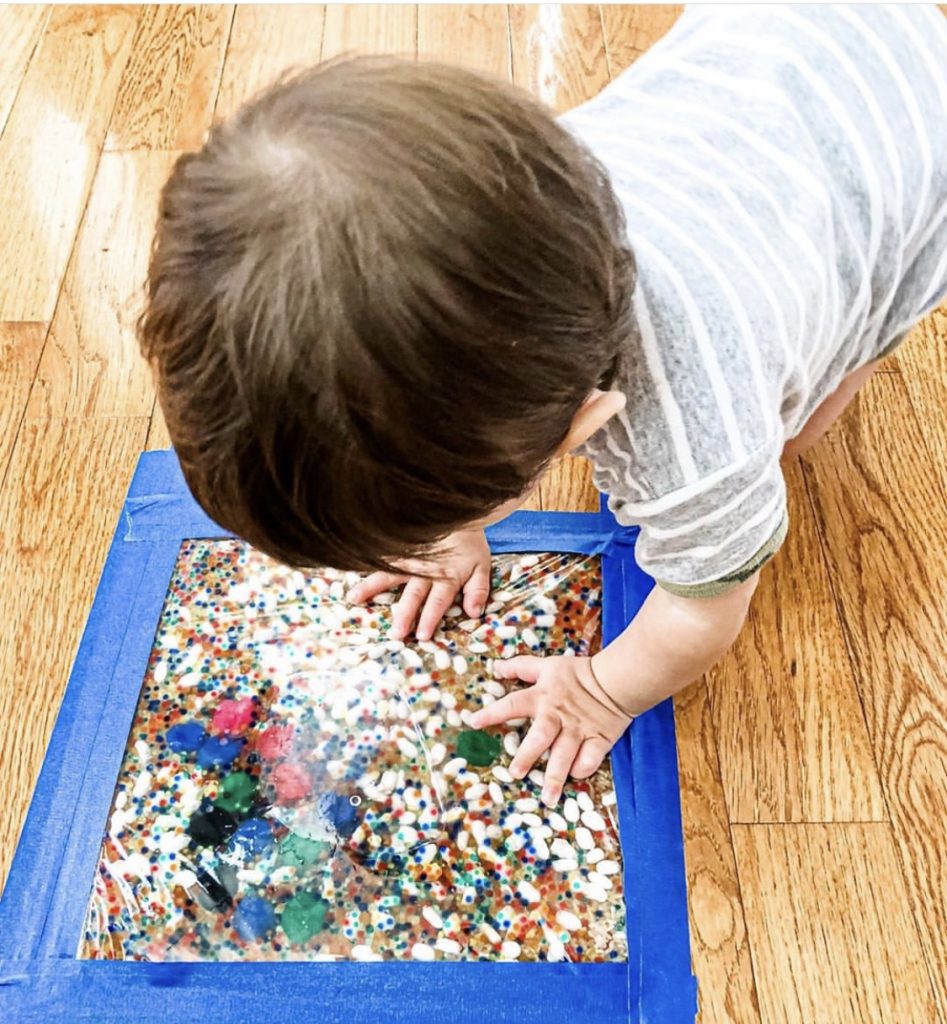
Why do babies need sensory play?
Babies need sensory play in order to properly develop their senses and self awareness. Sensory play exposes babies to new tastes, sounds, smells, sights and items to touch.
Learning while playing is so good for babies because it helps them to develop fine and gross motor skills. Sensory play helps babies build cognitive skills that help them to work through problems and develop the ability to trouble shoot.
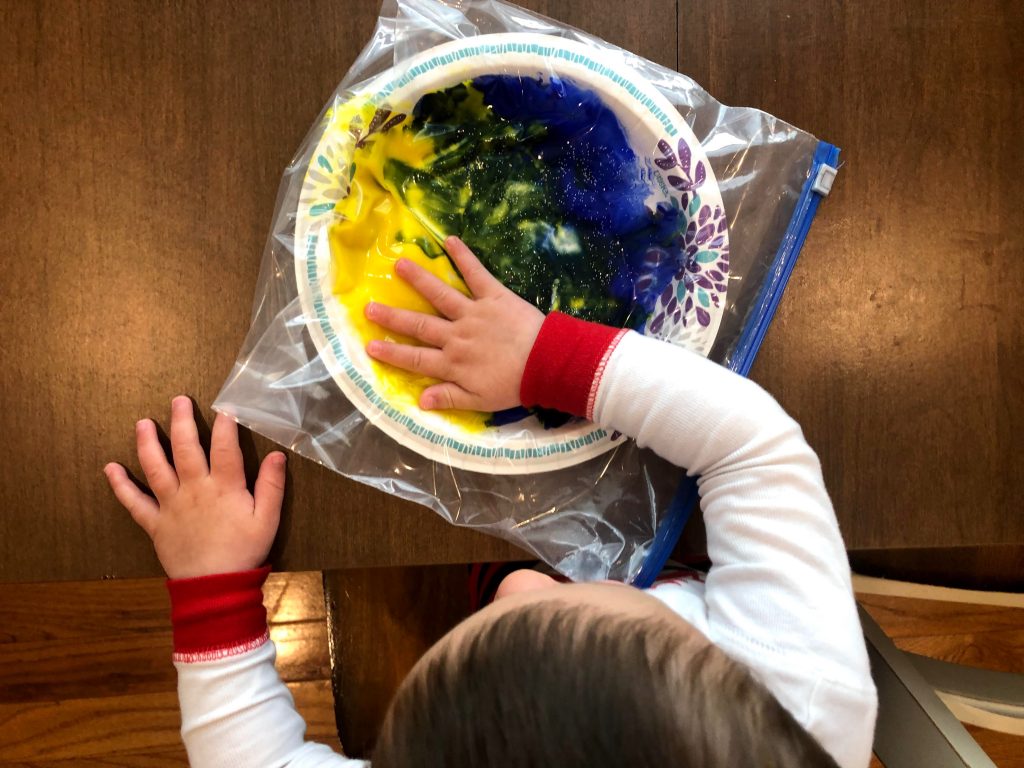
How to encourage sensory play for babies:
Introduce high contrast images: Babies LOVE high contrast images. High contrast images (like black and white cards or anything dark vs light) are easy for your baby to focus on.
Take a stroll: Going for a morning or evening walk is a great sensory activity for babies. The sound of the cars, birds chirping, etc is wonderful for hearing development. My babies have always loved being outside for this reason.
Try tummy time on the play mat: Some babies love it, some babies don’t, but it is important! If your baby detests tummy time, start out with a few minutes and build your way up to longer periods. Consider using a boppy pillow or rolled up towel/blanket to elevate baby’s chest to help make their experience more comfortable.
Explore different textures: Exploring different textures with a baby can be so much fun, my favorite thing it to watch their face! Playing with play dough, making slime, touching different objects with drastically different textures is so fun for babies and offers them the opportunity to experience new things!
Related Post: 16 Simple Activities for 4 Month Old Babies
Offer noisy toys: Rattles, squeaker toys, toys with beads or loud sounds tend to be some of my baby’s favorite toys when they were tiny. This is because they love experiencing sounds outside of what they normally hear.. it stimulates their brain!

Related Post: 15 Best Educational Toys for 9-12-Month-Olds to Maximize Stimulation and Development
Let your baby get mouthy: We all know babies love to chew on everything, and as long as it is safe, let them! My babies loved everything from silicone chew toys, wooden spoons, frozen washcloths, and really anything that they could get in their mouth!
Have fun with bath time: The water seems to be where my babies are happiest, so we did lots of baths! Having fun bath toys, bubbles and bath crayons on hand will make bath time an easy sensory activity.
Try Sensory Bags: Making sensory bags is a great time and babies will play with them for hours! They love the squishiness, shiny objects and fun toys inside.
Related Post: 26 Common Household Items That Make Cheap Baby & Toddler Toys
Easy sensory play activities for babies
- Playing in the mirror: Who is that baby is something my kiddos loved to play! It is so cute when they realize the baby they are looking at is really them. During this activity you can have them point to their eyes, nose, mouth, etc!
- Ice Cubes: Playing with ice cubes would be a great activity for a warm day. Your little one will have so much fun trying to keep hold of the ice cube and playing in the water as the ice melts.
- Texture Exploration: Introduce your baby to various textures by providing them with different fabrics, such as soft blankets, fuzzy socks, or textured toys. Allow them to touch, feel, and explore the different textures, stimulating their sense of touch.
- Bubble Wrap Popping: Lay out a sheet of bubble wrap on the floor and let your baby have fun popping the bubbles with their hands or feet. The sound, texture, and sensation of popping bubbles can be both entertaining and sensory stimulating.
- Water Play: Fill a shallow container or baby bathtub with a small amount of water and let your baby splash, play, and explore. You can add some baby-safe floating toys or objects to enhance the play experience.
- Feather Tickling: Gently stroke your baby’s skin with a soft feather or a fluffy feather duster. This activity can be a delightful way to engage their sense of touch and provide gentle sensory stimulation.
Messy baby sensory play
My kiddos seem to enjoy messy sensory play the most. I think it’s because they get to express themselves fully.
- Yogurt Finger Paint: For this activity it is probably best to strip baby down. You can use plain yogurt or add food coloring for fun pops of color. You can have your baby finger paint on paper, a sheet pan or any surface that is easily cleaned.
- Sensory Bins

Sensory bins can be especially messy if your baby starts throwing the objects inside..HA! Even though they can be messy, sensory bins are so fun for babies to learn and explore different textures and objects.
I love sensory bins because you can use whatever you have around the house and they are inexpensive to make!
- Edible Finger Painting: Use baby-safe, edible finger paints or make your own by mixing yogurt and food coloring. Let your baby explore and create colorful artwork using their fingers or hands.
- Sensory Bags: Fill sealable plastic bags with a variety of squishy and textured materials, such as gelatin, cooked pasta, or hair gel. Seal the bags tightly and let your baby squish, squeeze, and explore the contents.
- Shaving Cream Sensory Play: Spread a layer of shaving cream on a tray or table surface and let your baby freely explore the texture, squish it between their fingers, and make marks in it. Supervise closely to ensure they don’t put it in their mouth.
- Oobleck Play: Mix cornstarch and water to create a non-Newtonian fluid called oobleck. Place it in a large container and let your baby’s hands sink into the mixture, squeeze it, and watch as it behaves like a solid and a liquid.
- Water Play with Colored Ice Cubes: Freeze water with food coloring to make colored ice cubes. Let your baby play with them in a container or in the bath, watching the colors mix as the ice melts.
- Sensory Jello Dig: Prepare a shallow container of jello and hide small toys or objects inside. Let your baby dig and explore the jello with their hands to find the hidden treasures.
- Spaghetti Sensory Play: Cook spaghetti noodles until they are soft and let your baby explore the slippery, slimy texture. You can also dye the cooked spaghetti with food coloring for added visual appeal.
- Cloud Dough Play: Mix together flour and vegetable oil to create a moldable, sensory material called cloud dough. Let your baby squish, squeeze, and shape the dough to their heart’s content.
- Muddy Sensory Bin: Fill a container with soil or sand, add water to create mud, and provide your baby with small shovels, buckets, and toy animals for a messy outdoor-inspired sensory play experience.
- Sensory Foam: Create a sensory foam by mixing dish soap and water with an electric mixer until it becomes frothy. Let your baby explore the soft, fluffy foam with their hands and watch as it slowly dissolves.
Related Post: 7 Benefits of Sensory Bins and How They Support Child Development
Sensory activities for 3 month olds
- Balloons: Loosely tie a helium filled balloon to your baby’s foot or wrist. When baby starts kicking and moving their arms and legs they will be able to see the balloon moving too!
- Peek-A-Boo: Peek-A-Boo is a fun and classic game for little ones. I like using my hands or a blanket for this activity.
- Sensory Balls: Introduce your baby to different textured balls of various sizes, such as soft fabric balls, squishy sensory balls, or bumpy rubber balls. Encourage them to reach out and grasp the balls, exploring the different textures and shapes.
- Rattles and Shakers: Offer your baby various rattles and shakers with different sounds, textures, and shapes. Let them hold and shake the toys, stimulating their sense of touch, hearing, and coordination.
- Baby Massage: Gently massage your baby’s arms, legs, back, and feet using baby-safe oil or lotion. This can help soothe and relax your baby while providing tactile stimulation.
- Sensory Mobiles: Hang a simple, visually appealing mobile above your baby’s crib or play area. Choose one with bright colors, interesting shapes, and gentle movement to engage their visual and cognitive development.
- Soft Fabric Exploration: Provide your baby with soft, textured fabrics such as velvet, silk, or fleece. Let them touch and explore the different fabrics with their hands, feet, and face, stimulating their sense of touch and promoting sensory exploration.
- Musical Toys: Introduce your baby to musical toys or mobiles that play gentle tunes or sounds. This can help stimulate their auditory senses and encourage their interest in music.
- Tummy Time with Mirrors: During supervised tummy time, place a baby-safe mirror in front of your baby. This allows them to see their reflection and engage with their own visual self-awareness.
- Sensory Books: Choose baby-friendly board books with different textures, colors, and interactive elements like crinkly pages or touch-and-feel textures. Read aloud to your baby while allowing them to explore the book with their hands and eyes.
- Baby Gym: Set up a baby gym with hanging toys, rattles, and textures for your baby to reach out and interact with. This can encourage reaching, grasping, and hand-eye coordination.
- Soft Toy Exploration: Offer your baby a variety of soft, plush toys in different shapes, sizes, and textures. Let them explore and cuddle the toys, providing a sense of comfort and tactile stimulation.
Sensory activities for 6 month olds

If your babies are anything like mine, they looooove tissues. This toy allows them to pull out tissues to their hearts content. The magic tissue box encourages fine motor skill development and color distinguishment.

I love this 6-1 Play Cube! This toy encourages problem-solving and there are lots of different activities to keep your baby interested for a while!
- Sensory Bottles: Fill clear plastic bottles with various materials like colored water, glitter, small objects, or rice. Seal the bottles tightly and let your baby shake, roll, and explore the different sensory experiences.
- Texture Boards: Create a texture board using different fabrics, such as faux fur, satin, or rough textured materials. Attach the fabrics to a large cardboard or wooden board and encourage your baby to touch and explore the different textures.
- Baby Sensory Tunnel: Create a small sensory tunnel using blankets, pillows, and soft cushions. Place your baby inside the tunnel and let them crawl or roll through, experiencing different tactile sensations and promoting motor skills.
- Sensory Treasure Baskets: Fill a shallow basket with a variety of safe objects of different shapes, textures, and colors. Let your baby explore and discover the objects through touch, sight, and sometimes taste.
- Water Play with Cups: Fill a shallow container or bathtub with water and provide your baby with different cups and containers to pour, scoop, and splash. This activity encourages hand-eye coordination, fine motor skills, and sensory exploration.
- Tactile Sensory Play with Food: Introduce your baby to various safe, soft, and squishy foods like mashed banana, avocado, or cooked pasta. Let them touch, squeeze, and explore the different textures while supervised.
- Musical Exploration: Provide your baby with simple musical instruments like shakers, drums, or baby pianos. Let them explore the sounds, rhythms, and different ways to interact with the instruments.
- Sensory Balloon Play: Inflate a balloon and tie it securely. Show your baby how to pat or push the balloon gently, allowing them to explore the texture and movement. Always supervise closely to ensure safety.
- Baby-Safe Play Dough: Make baby-safe play dough using edible ingredients like flour, salt, and food coloring. Let your baby explore and squish the dough, promoting sensory stimulation and fine motor skills.
- Sensory Play with Soft Blocks: Offer your baby soft blocks with different textures, colors, and shapes. Encourage them to stack, squeeze, and explore the blocks, stimulating their sense of touch and hand-eye coordination.
Sensory activities for 9 month olds

This fun toy encourages crawling, but your baby will love trying to get to the balls inside and looking at all of the different pictures!

Your little one will love hearing all of the different animals sounds when looking through this book! My kiddos loved learning the animal sounds, and this book is a great place to start and engage that hearing sense!
- Sensory Bags with Gel: Fill sealable plastic bags with hair gel or a similar sensory material. Add small objects like plastic toys or foam shapes to the gel. Seal the bags tightly and let your baby explore the textures and objects by squishing, pressing, and manipulating the bags.
- Edible Sensory Play: Offer safe, edible sensory materials for your baby to explore, such as cooked pasta, cereal, or soft fruits like diced banana or avocado. Let them touch, squish, and taste the different textures and flavors.
- Sensory Balls with Bumps: Provide your baby with textured sensory balls that have bumps or ridges. These balls are designed to provide tactile stimulation and can be easily grasped and rolled by little hands.
- Sensory Scarves: Give your baby lightweight scarves or pieces of fabric in various colors. Encourage them to hold, wave, and explore the scarves, promoting visual tracking and sensory exploration.
- Water Play with Cups and Containers: Set up a water play station with different cups, containers, and scoops. Let your baby pour, fill, and splash water, developing fine motor skills, hand-eye coordination, and sensory exploration.
- Baby Sensory Bin: Create a sensory bin using a large container filled with safe materials like rice, shredded paper, or soft fabric scraps. Add baby-safe toys or objects for your baby to discover and manipulate.
- Sensory Exploration with Brushes: Provide different types of brushes, such as soft-bristle brushes, toothbrushes, or paintbrushes, for your baby to touch and explore. They can use the brushes on their own skin, textured surfaces, or even dip them in paint (non-toxic and baby-safe) for a mess-free painting experience.
- Stacking and Nesting Cups: Offer your baby a set of nesting cups that can be stacked or nested inside one another. These cups often have different textures or patterns, encouraging tactile exploration and promoting hand-eye coordination.
- Musical Sensory Shakers: Provide your baby with various sensory shakers that make different sounds when shaken, such as rattles or small maracas. Encourage your baby to explore the sounds and rhythms they can create.
- Sensory Play with Soft Textiles: Offer a range of soft textiles, like different textured blankets, towels, or stuffed animals, for your baby to touch, squeeze, and cuddle. This can provide sensory comfort and tactile stimulation.
Sensory activities for 12 month olds

Your little musician will love playing with this 3 in 1 music toy! The drums light up when they hit them and they will have the time of their life making their first tunes!

We love bubbles in our house. I love that these bubbles are no spill! My kids love to blow bubbles, chase and pop them.. and if I am not watching closely enough taste them, lol!

Bubble wrap is a crowd favorite of my kiddos. They love stomping on it, popping it in between their tiny fingers and they would do that for hours if they could!
Popping the bubbles with their fingers is great for developing fine motor skills and jumping on them is wonderful for gross motor. Sometimes the bubbles will make a tiny pop noise and sometimes it’s a loud noise.
These types of things are great for them to experience.
- Sensory Bin with Kinetic Sand: Create a sensory bin filled with kinetic sand for your baby to explore and play with. Add small cups, molds, or plastic animals for them to manipulate and discover different textures and shapes.
- Sensory Walk: Set up a mini obstacle course using soft mats, pillows, or foam tiles. Encourage your baby to crawl, walk, or navigate through the different textures and surfaces, providing tactile and proprioceptive stimulation.
- Water Play with Floating Toys: Fill a basin or bathtub with a few inches of water and offer floating toys or objects for your baby to play with. Let them splash, pour, and explore the water using their hands and various water-safe toys.
- Sensory Painting: Use non-toxic, washable finger paints or edible paints (made from food coloring and yogurt) to engage your baby in sensory painting. Provide large sheets of paper or a safe surface for them to create colorful and messy artwork.
- Sensory Tunnel: Create a small sensory tunnel using soft fabric or a large cardboard box. Encourage your baby to crawl or walk through the tunnel, experiencing different textures, colors, and spatial awareness.
- Musical Instruments: Offer your baby a variety of musical instruments, such as tambourines, drums, or xylophones. Encourage them to explore the sounds, rhythms, and different ways to interact with the instruments.
- Sensory Blocks with Sounds: Provide your baby with textured blocks that make different sounds when shaken or pressed. These blocks can stimulate their sense of touch, hearing, and fine motor skills.
- Sensory Discovery Bottles: Create sensory discovery bottles by filling clear plastic bottles with a variety of materials, such as colored water, glitter, small beads, or feathers. Seal the bottles tightly and let your baby shake, roll, and observe the contents.
- Texture Exploration with Fabric Swatches: Offer your baby a range of fabric swatches with different textures, such as velvet, satin, or bumpy fabric. Encourage them to touch and explore the fabrics, promoting sensory stimulation and tactile discrimination.
- Sensory Play with Foam Shapes: Provide your baby with foam shapes in various colors and sizes. Let them stick the foam shapes to a smooth surface, stack them, or explore their soft and squishy textures.
Sensory activities that don’t make a mess
Sometimes you may not feel like cleaning up a mess or you may not have the time. These activities are perfect for those times.

I love this tummy time water mat! This mat is great if your baby needs to be a little more upright during tummy time. It is squishy, which is great for the touch sense and has a lot of different animals to look at!

Your little one will love squeezing and squishing this glitter sensory bag! The best part is that it is mess free!
Sensory activities for babies for each of the 5 senses:
Taste
- Jello: Make a few different flavors of your favorite jello. Add the jello to a few different bowls and let your little one squish the jello and taste!
- Noodles: Make a batch of noodles and add in some food coloring. You can use whatever pasta you like best!
Touch

I loved using sensory books for my kiddos! They are a great, simple way for them to use their touch sense!

I love this sensory bin and the toys that it comes with! The bands around the box help to promote problem solving skills. The toys have different texture patters which is great for developing the touch sense.
Hearing
- Singing songs: I love to go onto YouTube and search for children’s songs. Another popular one in my house is CocoMelon.
- Filling Bottles: Fill plastic and glass bottles with water at different levels. Blow air into the bottles. You will be able to hear different pitches depending on the water level and type of bottle.
Sight

Babies love high contrast images because they are easier to see as their eyesight is still developing. When my babies were newborns they LOVED books like these!

This rattle is another good option for a high contrast toy. Not only will this baby stimulate their sight sense, but also their hearing sense because they double as windchimes!
Smell
- Scented Noodle Play: Make a batch of noodles and and separate the batch into a few different containers. Add a few drops of different essential oils to each container and have your little one get to sniffing!
- Smell Bottles: Find some containers, you can use bottles tupperware or whatever you have on hand. Add different things to the containers like orange peel, spices, coffee and let them smell!
DIY Baby Sensory Activities
I love a good DIY activity, especially if I can use items that I already have on hand!
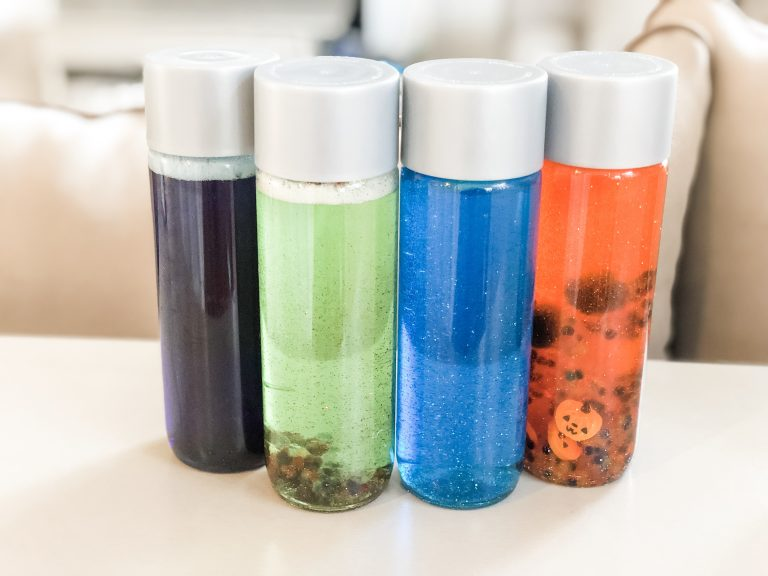
Sensory bottles are a huge hit in my house! They also double as calm down bottles for when your babies are a bit older. Sensory bottles are a fun and easy DIY sensory activity.
Try these bottles from amazon, and you can fill them with things like glitter, tiny erasers, pebbles, or food coloring. If you don’t have the things around the house and don’t want to buy them separately – check out this DIY Sensory Bottle kit!

Add dish soap and water to a bin. Use your mixer to activate the bubbles and then add some plastic toys! This activity is best to be done outside or in the bath tub where water messes are easy to clean up!
When should you do sensory activities with baby?
Everyone is different and we all have different schedules. For our family I liked to do sensory activities in the afternoon after nap.
It is best to avoid sensory activities when kiddos are on the tired side like right before naps or bedtime. You don’t want them to become overstimulated and cranky.
How often should you do sensory activities with baby?
You should do sensory activities with babies every day! Your activities don’t have to be complicated or intricate either!
Sensory activities are one of those things as a parent that is easy to over think, but you don’t have to. You can mix and match with simple sensory activities and ones that are a little more complex.
What if baby doesn’t like sensory activities?
If baby doesn’t like sensory activities, that’s okay! I recommend that you keep doing the sensory activities in short bits of time.
Allowing your baby to do sensory activities for short amounts of time in the beginning, allows them to get acclimated to things they aren’t yet used to.
Sensory play and activities is a vital part of a baby’s development. Encouraging your baby to experience new things is wonderful for their development and so fun to watch as a parent.
Did I miss any of your favorite activities? Let me know in the comments!
